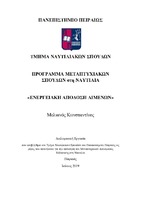Ενεργειακή απόδοση λιμένων

View/
Keywords
Geofencing ; Κλιματική αλλαγή ; Φορτία ; Εμπορευματοκιβώτια ; Ενεργειακή απόδοση λιμένων ; Οργανισμοί λιμένων Ελλάδας ; Κλιματική αλλαγήAbstract
Energy resources used for annual port operation were collected and recorded, in the present thesis. Port is defined as a predetermined area within which Carbon Footprint is calculated using Geofencing technology. Based on these data, port energy efficiency was estimated. It can be expressed as an index that denotes all energy resources used for the annual operation of the port and as a numerator all the activities completed using these energy resources.
In particular, electricity consumed for port operation, gasoline and diesel consumed for road transportation, diesel consumed for stationary combustion used for heating buildings, passenger stations and warehouses, were gathered. In addition, electricity required to handle bulk dry cargo, bulk liquid cargo, other general cargo as well as containers, was calculated. Finally, coastal and cruise ships, passengers, cars, trucks and motorbikes as well as employees at every port were presented. The aim of this presentation was to capture the additional Carbon Footprint burden of ships, passengers and vehicles on the port. However, energy consumed and consequently emissions generated in the port were not estimated in this thesis.
Port energy efficiency study, led to the conclusion that electricity consumed for port operation is the main activity that determines Port Carbon Footprint. The next major component contributing to Port Carbon Footprint is container management. These conclusions contribute towards improving energy efficiency, reducing greenhouse gas emissions and using renewable energy sources, which are the tree main ways to tackle climate change caused by anthropogenic factors. It therefore becomes clear the significance of port energy efficiency.


